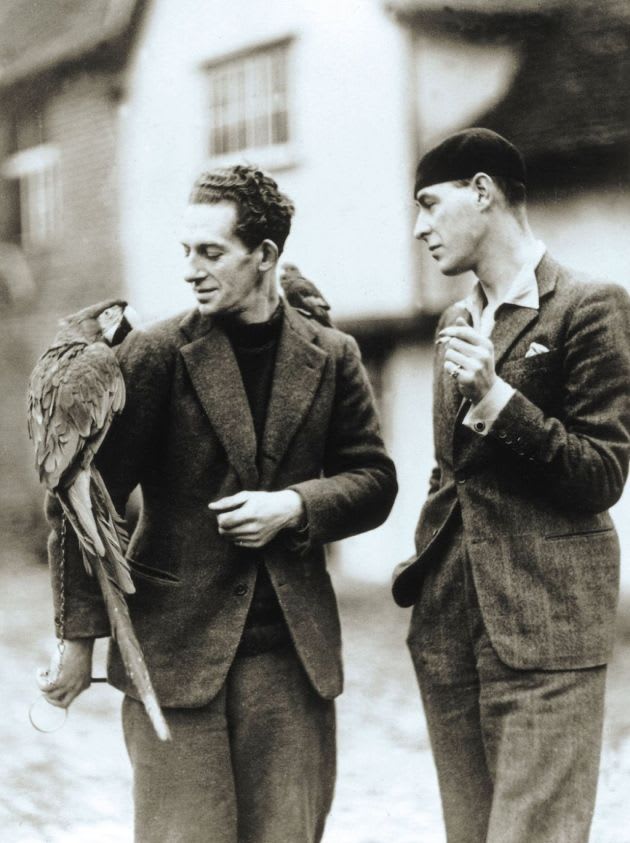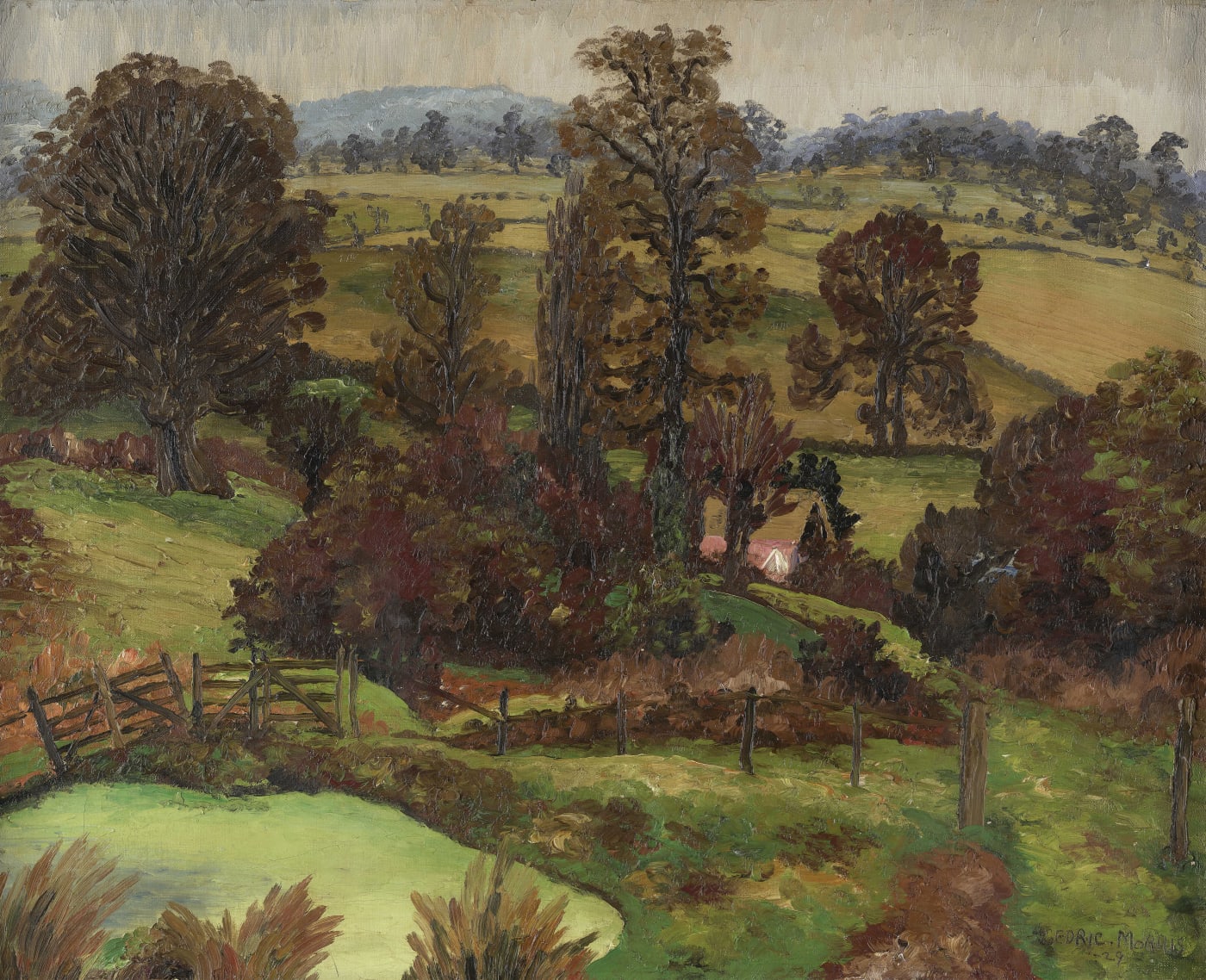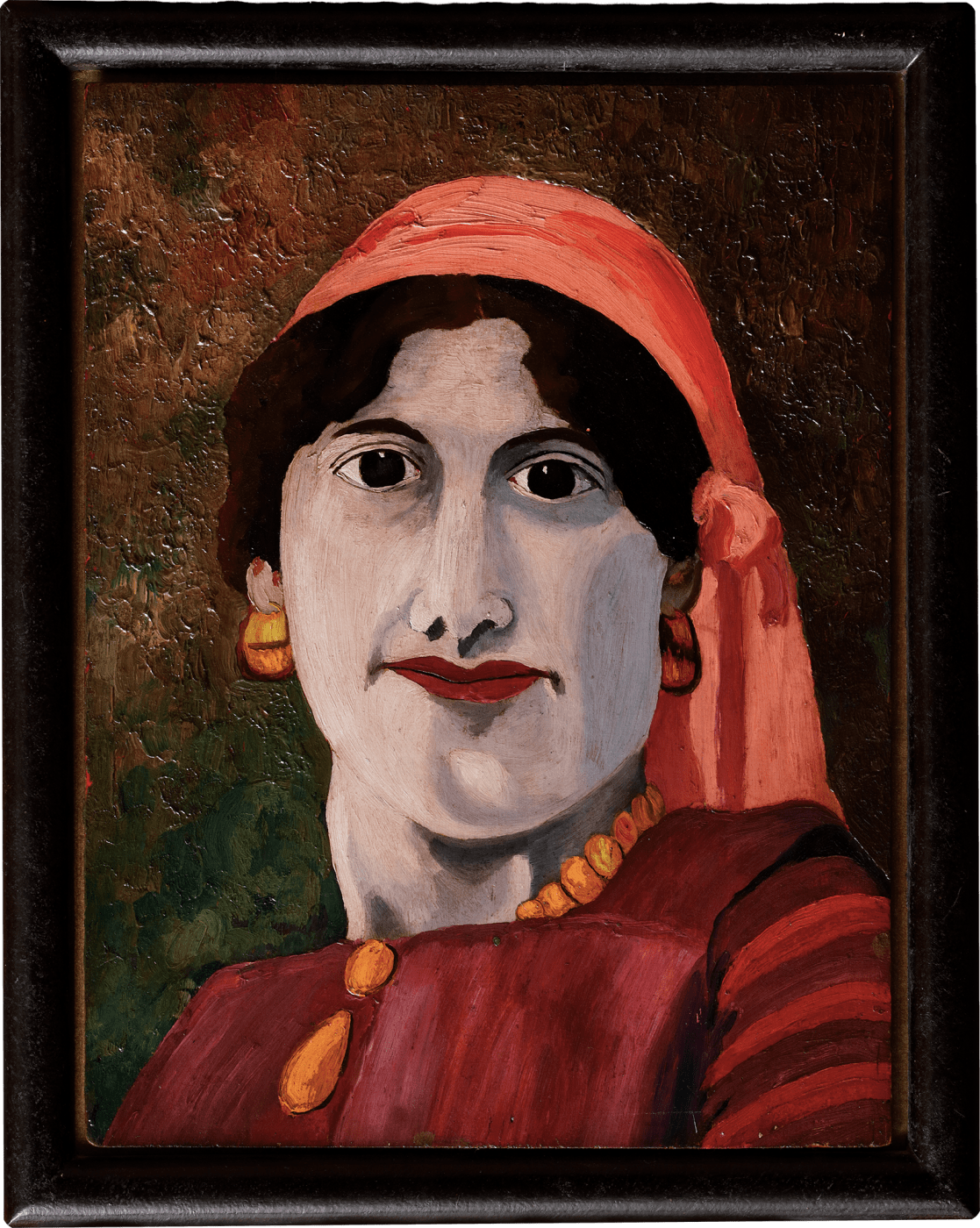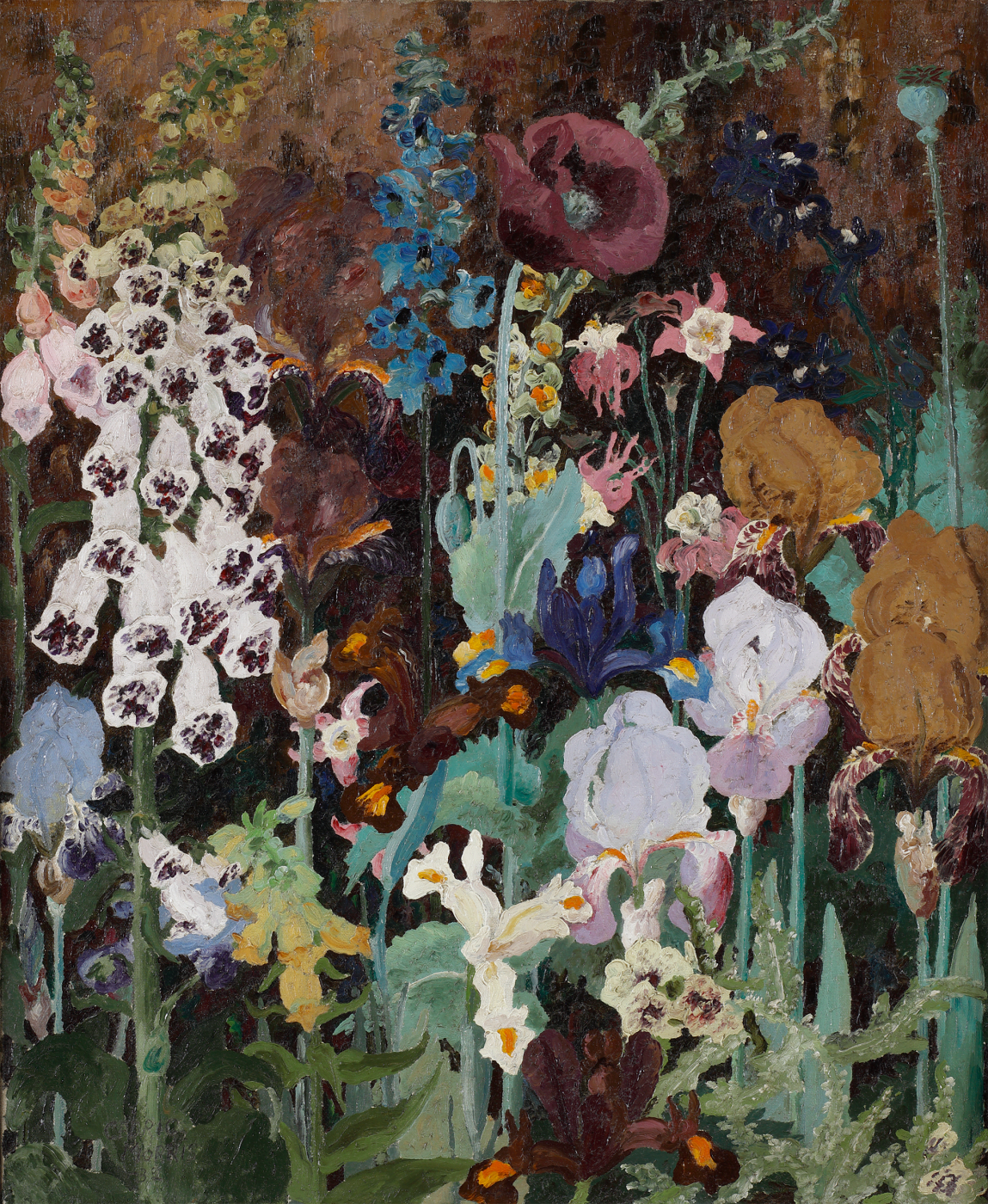
In the decade preceding this move to the country, Cedric, with considerable assistance from Lett, worked tirelessly to promote and sell his work by exhibiting with various art associations and dealerships around Europe. Their efforts had paid off; between 1920 and 1930 Cedric exhibited his work in twenty-two group shows and had two one-man exhibitions. By 1930, according to one commentator, Cedric had 'become "the rage"'.[1] With this success, however, came increased attention from the media and other art dealers who wanted to handle his work. Cedric was not normally one to shy away from public attention, however, the endless self-promotion that was required of him was beginning to take its toll. In an article published by The Daily Express in 1928, one journalist described how Cedric '…will discuss horses and dogs more readily than he will talk about his art.[2]
Cedric never enjoyed living in cities and between the years 1920 and 1927 when he and Lett were based in Paris, he would disappear for many weeks at a time travelling with friends around Europe and the Maghreb, painting landscapes and local people (Fig.1 and Fig.2). He likewise never considered London his home and with barely enough space in their flat for his growing collection of birds and cacti, Cedric and Lett set their sights on the countryside and in the winter of 1928 received a tip-off about a house in Suffolk that might soon become available.
The Pound (or Pound Farm), on the outskirts of Higham, was a narrow timber-framed Tudor farmhouse with later additions. It had no electricity, but the rent was acceptable, and it was set within two acres of wild gardens teaming with wildlife. They decided to take it and moved in early 1929. Although they quickly adjusted to their new life, Cedric and Lett were mindful not to sever their connections in London so decided to keep their flat in Great Ormond Street as a base where they could entertain friends and potential clients. They rented two further flats consecutively once the lease at Great Ormond Street expired - one on Gloucester Road and the other on Charlotte Street, keeping the latter until the late 1930s.
Together, Cedric and Lett transformed The Pound into a painter's paradise. Once the weeds and brambles were cut back Cedric set about creating the first of his many gardens with plants donated by his neighbours.[3] As the gardens developed, so too did the wildlife that populated them. Cedric would spend hours observing the hive of activity in his gardens, making notes on the comings and goings of the waterfowl and the growth of his eclectic but carefully curated collection of plants. Some of the wildlife was introduced by Cedric - one of The Pound's famous residents was a peacock named Ptolemy, who would swagger about the garden and wake their guests in the early hours of the morning.
The impact of their new surroundings on Cedric's work was profound and immediate. At his third one-man show staged at Arthur Tooth and Sons in March 1930 Cedric exhibited twenty-five works including a number of flower pieces and several views of the Suffolk countryside, fourteen of which found buyers. '…there has been no one-man show more important than this of Morris for the last few months and that is saying much', wrote one critic.[4] The reviews were positive, but Cedric was not happy - he often felt at odds with the people who were buying his art and disliked Tooth's approach to dealing which he considered too commercial to the detriment of his artistic freedom. Three months later he ended his agreement with them.
Over the next five years Cedric continued to paint in the countryside and exhibit in London. He staged three one-man shows in London and during this time painted some of his most impressive still-life works. Four of these works, Foxglove (1932), May Flowering Irises No. 2 (1935), Irises and Tulips (1935) and Still-life (1936) are included in this exhibition. Foxglove is a moody collection of horticultural delights focussed around several varieties of foxglove and set against an earthy background. It was exhibited by Cedric in 1934, the year before he painted May Flowering Irises, No.2. The latter is one of Cedric's finest paintings of irises from this date. He captures his subject in a way that only a painter with a profound understanding of this flower ever could, and through his shrewd observation, thickly applied paint and strong colour, manages to bestow on his subject a genuine sense of life and character.
In 1937 Cedric and Lett decided to open an art school in Dedham, a short distance from The Pound. They wanted to offer an alternative to the rigid formalities of other art schools where students were encouraged to pursue their own ideas based on what they saw around them. In early 1937 they drew up a prospectus and by spring the East Anglian School of Painting and Drawing was ready to accept students. One of the EASPD's earliest students was Lucian Freud who remembered with fondness Cedric's unusual working method, starting his painting in the top left corner before working his way down the canvas '…as if he was unrolling something from the top to bottom that was not actually there.'[5]
In July 1939 the building used by the EASPD in Dedham burnt down. The cause of the fire was never proven, but it was probably started accidentally by Lucian Freud or David Carr who were smoking a cigarette outside earlier that evening. Six months later war was declared on Germany and everyone's lives were thrown into uncertainty. With support from their friends, however, Cedric and Lett decided to look for a new building for the EASPD and settled on Benton End, a Tudor farmhouse on the outskirts of Hadleigh. It was here at Benton End that Cedric's creativity as a plantsman flourished.
Since moving to The Pound Morris had been gaining prominence within the gardening world as a breeder of irises and exotic plants, and it was to these subjects that Cedric turned during the war when travel was restricted. The Orange Chair (1944) is a typical wartime still-life with a few homegrown vegetables arranged on a table with fruit and a succulent. The emphasis in this work is less on the precise depiction of the objects before him as on the overall mood of the work with its sense of quiet foreboding.
This enforced isolation at Benton End during the war encouraged Cedric to paint, but also to put down in words his attitudes towards flower painting. In an article for the Studio in May 1942 he stated, 'Unless a flower painter can express the presence of entities other than human who concern themselves with the wellbeing of plants, he has not entirely achieved his object'. 'He must get across something as well as the esoteric meaning of plants. Flower painting has an extra set of values, which vary with individual artists but must always show great understanding and interest in plants.'[6] Few artists knew their floral subject as intimately as Cedric - since the start of the war he had raised around a thousand iris seedlings each year by hand-pollination, producing interesting colour variations including soft pinks and muted yellows for which he would gain great recognition.[7]
Prior to the war, Cedric would often paint his flowers against a plain, shallow backdrop, as seen in May Flowering Irises, No.2, however, during the 1940s he began to increase the depth of his still-life compositions and include interior and garden backdrops. Along with this recession of pictorial depth Cedric also began to experiment with a brighter palette and, as with his irises, a greater variation of colour. Three such works from this date demonstrating this artistic development are included in this exhibition - Summer Garden Flowers (1944), Early Sprint Plants (1946) and Flowers in an Interior (1949).
As well as painting flowers and garden produce, Cedric also painted landscapes and studies of birds during the wartime years. Kitchen Garden, Benton End (1944) depicts the rows of vegetables Cedric and Lett grew in their walled garden during the war. Some of the vegetables were quite exotic compared to what most of the country were eating at this date; asparagus, artichokes and even peppers were grown by Cedric and used by Lett to treat visitors and a few lucky students. Landscape at Hadleigh was also painted in the early 1940s, and like a lot of Cedric's wartime works is less painterly but with a greater emphasis on the smooth blending of complimentary colours.
During the early 1940s Cedric also found time to return to his native Wales. Since the early 1930s Cedric had become increasingly concerned with the plight of his countrymen in the face of factory and mine closures. In 1934 Cedric, along with other artists including Augustus John, gave their support to an exhibition of contemporary Welsh art in an attempt to change the attitude of local museums and councils and to encourage them to support and promote the arts by providing workspaces for new and visiting artists. Art, it was argued, was needed to lift the national spirit during this time of need. The exhibition was a huge success with over 2,000 visitors in the first week. Cedric returned to Wales to paint numerous times throughout his life and in 1943 painted a view of Dowlais Top in Merthyr Tydfil. There is a clear sense of nostalgia in the way Cedric has grouped together the small houses in the centre, embraced by the hill behind them. It feels almost like a memory from childhood and is a strong reminder of Cedric's pride in his ancestral roots.
When the war ended Cedric was once again able to travel around Britain and in 1947, the same year he inherited the baronetcy from his father, he visited his sister Nancy in Newlyn who was recovering from a nervous breakdown brought about by a failed relationship with a married woman. Whilst there Cedric painted an atmospheric view of her garden at Myrtle Cottage in his typically direct, rugged manner with the differing forms of the buildings and garden knitted together through thick, meticulously applied paint.
Back at home, Cedric's collection of irises was beginning to gain recognition and following a feature in Gardening Illustrated in 1946, Benton End had more visitors than ever before. One of Morris's best-known irises from this date is the 'Benton Edward Windsor' which he named in honour of the prince for his recognition of the hardships in Wales. This eye-catching iris - the first 'true' pink bred in Britain - features in several flower paintings by Cedric from this date. As post-war Britain recovered there was a renewed enthusiasm for gardening and Cedric's achievements within the field of iris breeding were acknowledged through several awards.
In 1950, after receiving a new passport, Cedric was able to travel abroad once again. He had always enjoyed travelling in his early years in Paris and London, but due to his commitments at the art school and the recent wartime restrictions he was not able to. This renewed sense of freedom coincided with a shift in tastes and fashion, and Cedric's work - once the epitome of the 'English look', was no longer in vogue. Instead of focussing on exhibitions, Cedric instead turned his attention to the art school and his gardening, cultivating rare and exotic plant specimens which he retrieved from his travels abroad.
Although Cedric continued to paint at Benton End and on his travels, his time at home was now generally spent tending to his gardens and encouraging his students. With the exception of a one-man show at the Leicester Galleries in 1952 he rarely exhibited his work, and his next major exhibition was not until his retrospective at the National Museum of Wales, Cardiff, in 1968.
The decision to move to the countryside marked a major turning point in Cedric's life and work. Away from the bustle and social politics of city life, Cedric, working first at The Pound and then Benton End, was able to concentrate uninterrupted on his art and in the years that followed produced some of the most original and atmospheric paintings of flowers and landscapes within twentieth century British art.
[1] Anon., 1930. Cedric Morris: Painter Who is 'the rage'. The Scotsman, 6 March, p. 12. In Morphet, R. Cedric Morris, Tate Gallery, London, p.32
[2] Daily Express, 1928. September. Quoted in St. Clair, H. 2019. A Lesson in Art and Life: The Colourful World of Cedric Morris and Arthur Lett-Haines. Pimpernel Press Ltd, p. 60.
[3] St. Clair, H. 2019. p. 69.
[4] The Scotsman, 1930. 31 March. Quoted in St. Clair, H. 2019. p. 72.
[5] Greig, G. 2013. Breakfast with Lucian: A Portrait of the Artist. Vintage.
[6] Morris, C. 1942. Studio, vol. CXXX, no. 590, May. Quoted in St. Clair, H. 2019. p. 125.
[7] St. Clair, H. 2019. p. 141.










